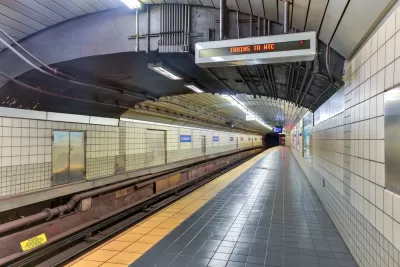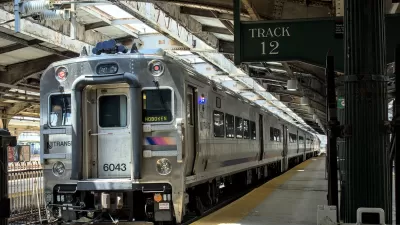After facing a series of setbacks, the plan to rehabilitate and expand train tunnels under the Hudson River is moving forward thanks to new federal support.

The tunnel linking New Jersey and New York by train under the Hudson River, first built more than a century ago, will undergo a $16 billion repair and expansion project starting in 2024 after the Gateway Development Commission took control of the project in September. As Dan Zukowski explains in Smart Cities Dive, “Legislation enacted separately by New York and New Jersey created the GDC in 2019. The commissioners include representatives of both states and Amtrak, which owns the tunnel and the rail line.”
Zukowski describes the project’s decade-plus history, noting that, despite a series of past delays, “With a more Amtrak-friendly Biden White House and money from the bipartisan infrastructure law, the tunnel project looks to be moving ahead.”
“Plans to add capacity with an additional tunnel go back to at least 2009, when work began on a project killed a year later by then-New Jersey Gov. Chris Christie. But Superstorm Sandy in 2012 flooded the tunnels with saltwater, damaging electrical and mechanical equipment and creating cracks in the concrete walls.”
The project could be completed in 2035. “After completing the new tunnel, the GDC will spend three years rehabilitating the existing tunnels, ultimately doubling track capacity to reduce delays and increase service.”
FULL STORY: $16B Hudson tunnel project for Amtrak set to begin construction in late 2024

Study: Maui’s Plan to Convert Vacation Rentals to Long-Term Housing Could Cause Nearly $1 Billion Economic Loss
The plan would reduce visitor accommodation by 25,% resulting in 1,900 jobs lost.

North Texas Transit Leaders Tout Benefits of TOD for Growing Region
At a summit focused on transit-oriented development, policymakers discussed how North Texas’ expanded light rail system can serve as a tool for economic growth.

Using Old Oil and Gas Wells for Green Energy Storage
Penn State researchers have found that repurposing abandoned oil and gas wells for geothermal-assisted compressed-air energy storage can boost efficiency, reduce environmental risks, and support clean energy and job transitions.

Private Donations Propel Early Restoration of Palisades Playground
Los Angeles has secured over $1.3 million in private funding to restore the Pacific Palisades playground months ahead of schedule, creating a modern, accessible space that supports community healing after recent wildfires.

From Blight to Benefit: Early Results From California’s Equitable Cleanup Program
The Equitable Community Revitalization Grant (ECRG) program is reshaping brownfield redevelopment by prioritizing projects in low-income and environmental justice communities, emphasizing equity, transparency, and community benefits.

Planting Relief: Tackling Las Vegas Heat One Tree at a Time
Nevada Plants, a Las Vegas-based nonprofit, is combating the city’s extreme urban heat by giving away trees to residents in underserved neighborhoods, promoting shade, sustainability, and community health.
Urban Design for Planners 1: Software Tools
This six-course series explores essential urban design concepts using open source software and equips planners with the tools they need to participate fully in the urban design process.
Planning for Universal Design
Learn the tools for implementing Universal Design in planning regulations.
Ascent Environmental
Borough of Carlisle
Institute for Housing and Urban Development Studies (IHS)
City of Grandview
Harvard GSD Executive Education
Toledo-Lucas County Plan Commissions
Salt Lake City
NYU Wagner Graduate School of Public Service





























